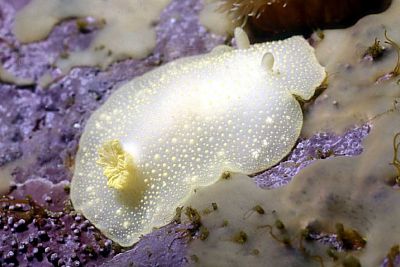
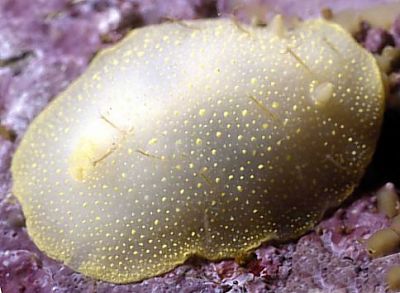
Cadlina cf. luteomarginata
Order: NUDIBRANCHIA
Suborder: DORIDINA
Superfamily: EUDORIDOIDEA
Family: Chromodorididae
DISTRIBUTION
Nth Atlantic, Gulf of Maine, New England, West coast of Ireland.
PHOTO
New England, USA - Atlantic coast - with 'slime sponge Halisarca. Aprox 3 cm long. Photo: Paul Young
Bleakney, 1996 considers this animal from the Atlantic coast of Nth America to be identical to the west coast species Cadlina luteomarginata MacFarland, 1966 (= C. marginata). Without anatomical information it is difficult to be sure but in colour there are differences. In C. luteomarginata the yellow mantle border is a continuous yellow line while in the east coast species there is a very diffuse line, which is sometimes absent. It appears that Lemche (in Just & Edmunds, 1985) reported this as an unnamed species, Cadlina sp. A, from Ireland.
Of interest is the apparent food of the two 'species'. Cadlina luteomarginata is reported to feed on the spiculate sponges Halichondria, Myxilla, and Higginsia. Although nothing has been reported on the food of the Atlantic 'species', Paul Young's upper photo shows an animal in an area partially covered with a thin leathery sponge which looks very like a slime sponge such as Halisarca sp., which are the preferred food of some species of Cadlina such as C. laevis. The identity of this species can only be resolved by looking at its anatomy. In the mean time I consider it appropriate to keep it separate from C. luteomarginata.
References:
• Just, H. & Edmunds, M. (1985) North Atlantic Nudibranchs (Mollusca) seen by Henning Lemche. Supplement 2, Ophelia: 1-70.
• MacFarland, F. M. (1966) Studies of opisthobranchiate mollusks of the Pacific coast of North America. Memoirs of the California Academy of Sciences, 6: 1-546.
Rudman, W.B., 2001 (June 25) Cadlina cf. luteomarginata [In] Sea Slug Forum. Australian Museum, Sydney. Available from http://www.seaslugforum.net/find/cadlcflute
Related messages
Cadlina but which one?
February 13, 2002
From: Alan Shepard
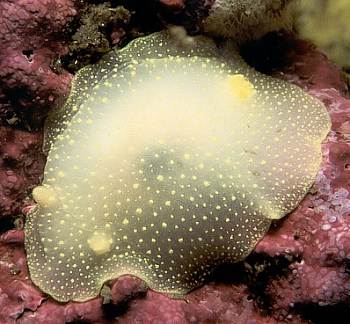
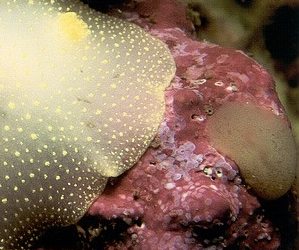
Bill,
The nudibranchs here in New England and particularly Cape Ann, Massachusetts are quite abundant right now. I don't know why - maybe the fact that the waters got colder earlier and drove the fish to deeper water allowed the nudibranchs to go unmolested. I'm hoping to photograph many of them this winter.
Anyway I know the attached photo is of a Cadlina but is it C. laevis or C. luteomarginata? Most of our local ID books, and there are few of them, seem to result in a match with C. laevis. But when I look over your site I lean towards C. luteomarginata. Any help would be appreciated.
Thanks,
Alan Shepard
aetobatus@aol.com
Shepard, A., 2002 (Feb 13) Cadlina but which one?. [Message in] Sea Slug Forum. Australian Museum, Sydney. Available from http://www.seaslugforum.net/find/6169Dear Alan,
The jury is still out on this one. Have a look at the Cadlina cf. luteomarginata and the attached messages there. Your common east coast Cadlina has been identified with the west coast C. luteomarginata but it has consistent colour differences and feeds on a quiet different group of sponges. I have included a part of your photo (lower right) showing a small colony of the slime sponge, Halisarca which seems to be the food of your east coast animal.
This food choice is the same as Cadlina laevis from Europe but there are colour differences with that species. Until its anatomy is looked at there is not much more to say. What would be worth looking out for is an animal in the process of laying eggs. a photo of the egg ribbon, including a close-up showing how large the individual eggs are, would be a very valuable piece of information, as the size of the eggs can give us clues to the type of larval development the slug has.
Best wishes,
Bill Rudman
More on Cadlina from New England
June 27, 2001
From: Paul Young

Here are a few more photos of the White Doris.
Perhaps this will help clear up their identification.
The first shows the gills about half out (They retract the gills when disturbed, so it is hard to photograph them). The grey area to the right is the sponge the animal eats. The animals are cream - white and semi-transparent; I wouldn't call them greenish. The tubercles are yellow.
In checking our files, some of the White Doris shots do show a yellow border to the mantle to some extent. Could they be Cadlina marginata instead of C. laevis?
Paul Young
young@underwater.org
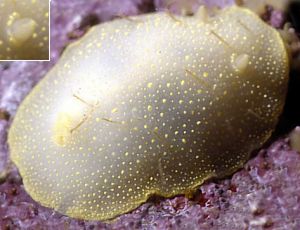
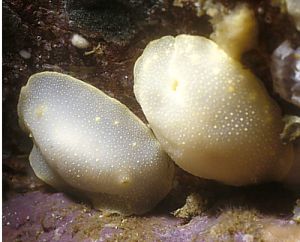
Dear Paul,
The extra photos are very welcome. They certainly show the animal that Sherman Bleakney calls C. marginata in his book. I am not sure why he has resurrected the name Cadlina marginata MacFarland, 1905 which MacFarland replaced with C. luteomarginata in 1966. The name 'marginata' was first used for another species of Cadlina [Doris marginata Montagu 1804] one hundred years before MacFarland and so is unavailable.
As I discuss at the top of the page I think the North Atlantic and North Pacific animals are probably different species but it will need an anatomical study to be sure. The food sponge of your species is interesting as it seems to be a slime sponge, rather than the spiculate sponges the Pacific species eats. Do you know if your sponge has a name? Or can you describe it? Is it smooth, leathery and tough? Does it seem to have sponge spicules? Another interesting point would be a photo of its egg ribbon. Some species have big eggs and the young hatch from them directly as miniature slugs, while in other species there are many small eggs which develop into microscopic veliger larvae which hatch out of the egg ribbon and swim off in the plankton. A photo may give us some clues to the size of the eggs.
As I said before, this is a very interesting find.
Best wishes,
Bill Rudman
Re: Cadlina from New England
June 26, 2001
From: Irina Roginskaya
Dear Bill,
About the Cadlina from New England. Our common White Sea C. laevis are completely milk white, only with irregularly placed scanty lemon- yellow spots along the mantle border. Never green. Perhaps the specimens studied by Paul Young eat green sponges? Ours - invariably white.
Best regards.
I. Roginskaya.
irina7@hotmail.com
Roginskaya, I., 2001 (Jun 26) Re: Cadlina from New England. [Message in] Sea Slug Forum. Australian Museum, Sydney. Available from http://www.seaslugforum.net/find/4659Thanks Irina,
I wouldn't actually describe Paul's Cadlina as green, it seems to be basically a translucent colour, lacking in pigment except for the opaque yellowish tubercles.
Best wishes,
Bill Rudman
Cadlina from New England
June 23, 2001
From: Paul Young
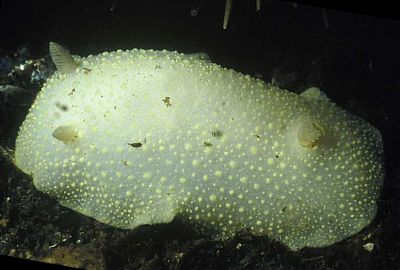
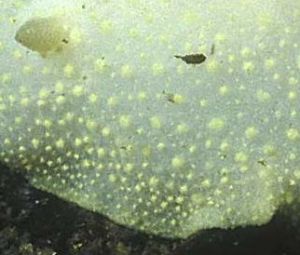
Locally this is usually called the White Atlantic Cadlina or the White Doris. We believe it is C. laevis.
It eats sponges. It is locally common North of Cape Cod, [New England, USA - Atlantic coast]. We usually find lots of them or none at all. They are about 3 cm long.
Paul Young
young@underwater.org
Young, P., 2001 (Jun 23) Cadlina from New England. [Message in] Sea Slug Forum. Australian Museum, Sydney. Available from http://www.seaslugforum.net/find/4618Dear Paul,
I think you have another interesting animal here, but I have no personal experience of these northern hemisphere species of Cadlina. My understanding is that Cadlina laevis has white capped tubercles, and the only yellow it has are in the mantle glands, which form a submarginal row along each side of the mantle.
There are a number of species with a similar colour pattern. If you ignore those species with dark gills and rhinophores, there are a few species with a similar colour pattern. Most similar is Cadlina luteomarginata MacFarland, 1966, which is found on the west coast of North America, and has also ben reported from the east coast (Bleakney, 1996. It has a yellow mantle border and the low mantle tubercles can be tipped with yellow. The translucent white gills are tipped with yellow. Cadlina rumia Marcus, 1955 which is found in the west Atlantic from Florida to Brazil, and Cadlina modesta Macfarland ,1966 which lives on the west coast of Nth America, are both translucent white with a submarginal row of yellow glands, much like in C. laevis.
Basically your photo dosn't seem to fit any described species. Comments from anyone would be very welcome
Best wishes,
Bill Rudman
